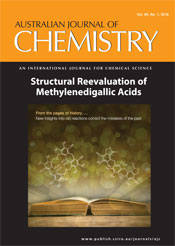
Australian Journal of Chemistry
Volume 69 Number 1 2016
CH15304Hydrogel-Derived Soft Materials for Biomimetic and Energy-Related Functions
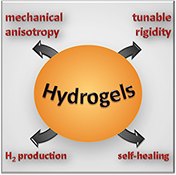
Hydrogel-derived materials demonstrate potential to deliver excellent biomimetic and energy-related applications. The recent developments point to a bright future for these soft functional materials.
CH15120Structural Reevaluation of the Crystalline Methylenedigallic Acids
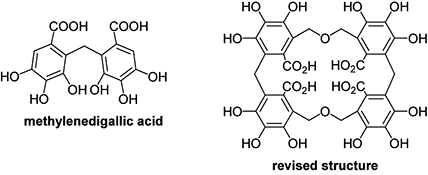
Truth is stranger than fiction. New insights into an old reaction reveal that the major product from the condensation of gallic acid with formaldehyde is not methylenedigallic acid, but rather the more complex calixarene.
CH14735A Label-Free Colorimetric Biosensor for 17β-Estradiol Detection Using Nanoparticles Assembled by Aptamer and Cationic Polymer
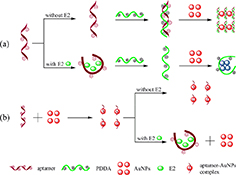
In this paper, a sensitive and selective biosensor for the detection of 17β-estradiol (E2) was developed using gold nanoparticles (AuNPs), label-free E2-specific aptamer, and poly(diallyldimethylammonium chloride) (PDDA).
CH15200Syntheses and Structures of Homodinuclear (Na–Na) and Heterodinuclear (Cu–Na, Cu–K) Metal Complexes
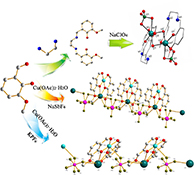
We examine two types of heterodinuclear metal complexes [CuIINaI(HL1)2(SbF6)]n (1) and [CuIIKI(HL1)2(PF6)]n (2), which are derived from the tridentate ligand o-vanillin (HL1), including transition metal ions (CuII) and main group metal ions (NaI and KI). Furthermore, we utilise N,N′-ethylene-bis(3-methoxysalicylideneimine) (H2L2), a kind of Schiff base, to synthesise a homodinuclear sodium complex [Na2(H2L2)2] (3) and studied the structure of this complex.
CH15141Efficiently Converting CO2 into C2H4 using a Porphyrin–Graphene Composite Photocatalyst
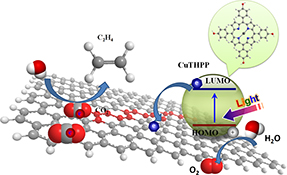
Novel photocatalysts consisting of porphyrin and graphene were designed to reduce CO2 to hydrocarbons under visible light. These catalysts can (1) effectively reduce CO2 to hydrocarbons, particularly to C2H4; (2) selectively control the photogenerated electrons transfer from graphene to CO2 rather than H2O; and (3) induce reduction and oxidation on different components of the photocatalyst, thus reducing the complexity of investigating the mechanism of the photocatalyst.
CH15180Diverse Structures and Physicochemical Properties of Four Zinc–Tripyridyltriazole Coordination Polymers Regulated by Counter-Ions
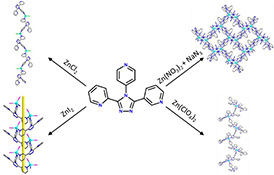
The construction of four distinct ZnII coordination polymers has been successfully achieved based on a neutral versatile tripyridyltriazole linker, the diverse structures of which can be effectively regulated by the synergistic modulation of counter-ions and adaptable conformations of the organic linker.
CH15250Fabrication of TiO2/Ag/Ag2O Nanoparticles to Enhance the Photocatalytic Activity of Degussa P25 Titania

A simple chemical reduction approach was used to synthesize Ag nanoparticles (NPs) over a reputed photocatalyst, Degussa P25 titania. Ag NPs were then partially oxidized by treatment with hydrogen peroxide. The resulting P25/Ag/Ag2O nanocomposite exhibited better photodegradation activity than P25 and Ag3PO4 for non-biodegradable dyes under visible light irradiation.
CH15162Alternating Ring-Opening Copolymerization of Cyclohexene Oxide and Maleic Anhydride with Diallyl-Modified Manganese(III)–Salen Catalysts
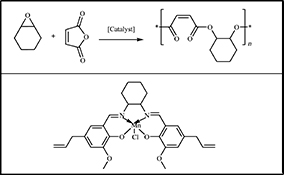
The ring-opening copolymerization of CHO and maleic anhydride (MA) in bulk and solution was studied in detail using a series of diallyl-modified (salen)Mn complexes. The best catalytic performances were obtained using the following copolymerization procedure: CHO/MA/catalyst/DMAP molar ratio of 250 : 250 : 1 : 1, polymerization time of 300 min, and reaction temperature of 110°C in toluene.
CH15185Construction of a New ZnII Coordination Polymer for Selective Fluorescence Sensing of CCl4
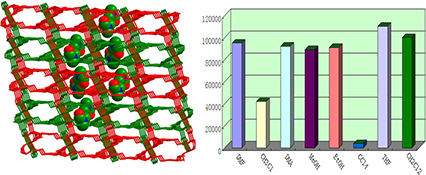
A new ZnII coordination polymer based on trinuclear [Zn3(COO)6] cluster subunits has been obtained under solvothermal conditions. Luminescence properties for the title compound dispersed in different organic solvents reveal that it has a unique selectivity for detection of CCl4 molecules via a fluorescence quenching mechanism.
CH15445N,N-Dialkyl-N′-Chlorosulfonyl Chloroformamidines in Heterocyclic Synthesis. Part XIII. Cleavage and Rearrangement Reactions of Pyrazolo[1,5-b][1,2,4,6]thiatriazine 1,1-Dioxides

Acidic cleavage of pyrazolo[1,5-b][1,2,4,6]thiatriazines 1 afforded pyrazolo-guanidines, which upon reaction with one-carbon electrophiles, provided various 4-substituted pyrazolo[1,5-a][1,3,5]triazines. Alcoholysis and aminolysis of 7-benzyl-pyrazolo[1,5-b][1,2,4,6]thiatriazines 2 afforded sulfamates and sulfamides. Thermal rearrangement of compounds 2 furnished 6-benzyl-pyrazolo[3,4-e][1,2,4]thiadiazines.
CH15161DFT and SERS Study of Adsorption of 1,4-Dimethoxy-2-nitro-3-methylanthracene-9,10-dione onto Silver Nanoparticles
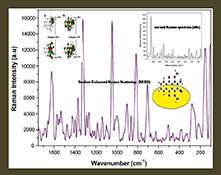
The adsorption mechanism, orientation of 1,4-dimethoxy-2-nitro-3-methylanthracene-9,10-dione molecule onto silver surface, and charge transfers have been investigated based on DFT and SERS methods. As anthraquinone derivatives have been recently used as potent anti-tumour drugs, the adsorption studies reported in the current investigation can pave way to the potential application of DMNMAD in drug delivery.
CH14705A New Method for the Label-Free Detection of Vascular Endothelial Growth Factor Based on DNAzymes
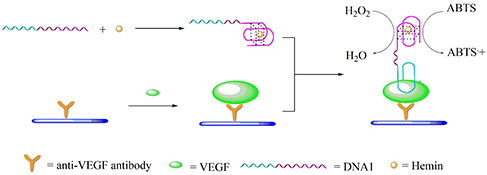
An ultrasensitive colorimetric sandwich sensor for vascular endothelial growth factor (VEGF) detection is introduced. The peroxidase-like DNAzyme catalyzes the oxidation of 2,2′-azino-bis(3-ethylbenzothiazoline)-6-sulfonic acid, which generates a blue–green colorimetric signal.
CH15184Kinetics of Hydrolysis of N-Methyl-2,4-dithiophenobarbital
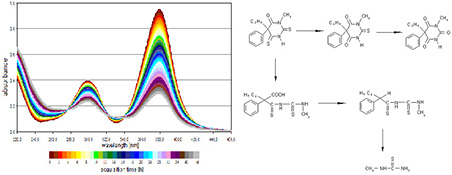
Using N-methyl-2,4-dithiofenobarbital as an example, we investigated how the position of the methyl group, and introducing a second sulfur atom in place of oxygen in the carbonyl group, affects the rate of hydrolytic degradation. The method was also applied to study the effect of pH and temperature and a probable pathway of chemical changes.
CH15267A New Protocol for Total Synthesis of Natural Product Frutinone A and Its Derivatives
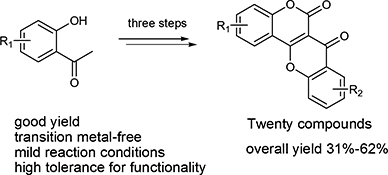
A new protocol for total synthesis of natural product frutinone A was accomplished in three steps by using inexpensive 2′-hydroxyacetophenone as starting material. Twenty target compounds were synthesized. The synthetic route features good yield, transition metal-free and mild reaction conditions, and high tolerance for functionality, thereby allowing easy substitutions around the frutinone A core.
CH15152Preparation and Gas Sensing Properties of Hierarchical Flower-Shaped Bi2WO6
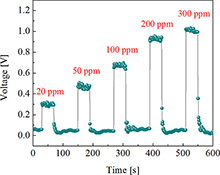
The Bi2WO6 sensor exhibits ultra-fast response (1-2 s) and fast recovery time (6–12 s) in the detection of ethanol, and high selectivity to other gases such as methanol, benzene, dichloromethane, and hexane.
CH15276Water-Soluble Copolypeptides with Oligo-Ethylene-Glycol and Benzyl Pendants: Synthesis, Characterization, and Thermoresponsive Properties
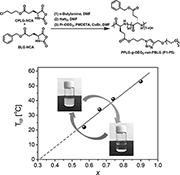
A series of random copolypeptides, i.e. poly(γ-propyl-l-glutamate)-graft-(oligo-ethylene-glycol)-random-poly(γ-benzyl-l-glutamate)s (PPLG-g- OEG3-ran-PBLG) with similar main chain lengths and various compositions of oligo-ethylene-glycol (OEG) and benzyl pendants were readily prepared in three steps, including ring-opening polymerization, nucleoplilic substitution, and copper-mediated alkyne–azide 1,3-dipolar cycloaddition. The cloud point temperature, in the range of 22–53°C, can be readily obtained by controlling the OEG/benzyl composition.
CH15157Immobilization of BiOBr/BiOI Hierarchical Microspheres on Fly Ash Cenospheres as Visible Light Photocatalysts
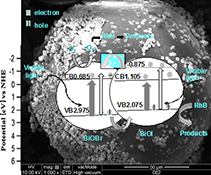
Three-dimensional (3D) BiOBr/BiOI hierarchical microspheres were successfully fabricated on the surface of fly ash cenospheres (FACs) via a facile one-pot solvothermal method for the first time. The photophysical properties of the as-prepared samples were fully characterized. The photodegradation tests examining the removal of rhodamine B from water under visible light irradiation (λ > 420 nm) showed that BiOB/BiOI-FACs displayed superior photocatalytic activity to BiOBr-FACs and BiOI-FACs. The enhanced photocatalytic activity mechanism of BiOB/BiOI-FACs was proposed.



